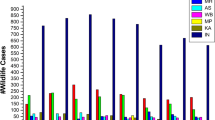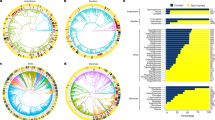Abstract
Wildlife is often poorly managed, poaching is part of such a problem. In times of globalization, international demands can easily put huge pressures on endemic species in remote locations and small nations. Nepal faces such a situation and here we present the first study of wildlife poaching, as identified from media reports. Many species were identified from confiscation reports made by local police and border guards. We focused on the Nepali-Chinese and Nepali-Indian border and present numbers, estimates and an outlook on what to do regarding poaching reduction.
Publisher’s Note – Springer Nature remains neutral with regard to jurisdictional claims in published maps and institutional affiliations.
Access this chapter
Tax calculation will be finalised at checkout
Purchases are for personal use only
Similar content being viewed by others
References
Adhikari D, Pokhrel J, KC S, Rai B (2011) The media in the news 2010: an assessment report in the context of Nepal’s post conflict transition (with South-central Asian trends). Media Foundation Nepal, Kathmandu
Aryal RS (2004) CITES implementation in Nepal and India (law, policy and practice). Bhrikuti Academic Publication, Kathmandu
Baillie JEM, Hilton-Taylor C, Stuart SN (eds) (2004) 2004 IUCN red lists of threatened species. A global species assessment. IUCN/Cambridge, Gland/Cambridge
Banks D, Desai N, Gosling J et al (2006) Skinning the cat: crime and politics of the big cat skin trade. Environment Investigation Agency/Wildlife Protection Society of India, London/New Delhi
Barnes LJ (1989) The overt illegal fur trade in Kathmandu, Nepal. Inverness Research Associates, Inverness
Bhuju UR, Aryal RS, Aryal P (2009) Reports of the facts and issues on poaching of mega species and illegal trade in their parts in Nepal. Transparency International Nepal, Kathmandu
Blundell AG, Mascia MB (2005) Discrepancies in reported levels of international wildlife trade. Conserv Biol 19:2020–2025. https://doi.org/10.1111/j.1523-1739.2005.00253.x
Boyko V, Boyko MT (2007) Climate change and journalistic norms: a case study of US mass-media coverage. Geoforum US 38(6):1190–1204
Broad S, Mulliken T, Roe D (2003) The nature and extent of legal and illegal trade in wildlife. In: Oldfield S (ed) The trade in wildlife. Earthscan Publications Ltd, London
Brown P, Davies B (2014) Trading to extinction. Dewi Lewis Publishing, Wales
CEPF (2004) Opening remarks. CEPF Project completion report. www.cept.net. Accessed on 14 Jan 2016
Challender D, Baillie J, Ades G et al (2014) Manis pentadactyla. The IUCN Red List of Threatened Species. Version 2014.3. www.iucnredlist.org. Downloaded on January 2016
Chapagain D, Dhakal J (2002) CITES implementation in Nepal. Department of National Parks and Wildlife Conservation, Kathmandu
Chaungyalpa D (1998) A report on the monitoring of wildlife trade in Nepal: case study of the wildlife watch group, WWF Nepal program
Cook D, Roberts M, Lowther J (2002) The international wildlife trade and organised crime: a review of the evidence and the role of the UK. WWF-UK, Godalming, pp 1–30
Dinerstein E, Loucks C, Wikramanayake E et al (2007) The fate of wild tigers. Bioscience 57:508–514
Dinerstein E (2003) The return of the unicornis: the natural history and conservation of the greater one-horned rhinocereos. Columbia University Press, New York
DNPWC (2014) A press release on the first world wildlife day. Department of National Parks and Wildlife Conservation, Kathmandu
DNPWC (2007) Annual report 2006–2007. Ministry of Forest and Soil Conservation, Department of National Parks and Wildlife Conservation, Kathmandu
Dongol RD (2015) Illegal Wildlife Trade in Nepal: A Case Study from Kathmandu Valley, M.Sc. Thesis submitted to Norwegian University of Life Sciences, faculty of Social Sciences, department of International Environment and Development Studies (Noragric)
Dongol Y, Heinen JT (2012) Pitfalls of CITES implementation in Nepal: a policy gap analysis. Environ Manag 50:181–190. https://doi.org/10.1007/s00267-012-9896-4
EIA (2004) The tiger skin trail. Environmental Investigation Agency, London
Felbab-Brown V (2011) Foreign policy at Brookings: the disappearing act – the illicit trade in wildlife in Asia, Working Paper 6. The Brookings Institution, New York
Gearson H, Cudmore B, Nicholas E et al (2008) Use of the Taxonomic Serial Number (TSN) as a required data element in international wildlife trade: response to Fragoso and Ferriss. Conserv Biol 22(6):1651–1654
Global Sherpa (2011) News trends in sustainability and development issues. Retrieved 14 January 2016 from http://www.globalsherpa.org/category/environment
Gorkhapatra S (2015). http://gorkhapatraonline.com/. Date accessed 12 Mar 2015
GreenCom (2001) Environmental education and communication (EEandC) for behavior change. Its role in forest, water and biodiversity resource management for sustained economic growth in Bolivia. Environmental Education and Communication (GreenCom) Project, p 106
Gurung R (2011) Journalism in transition: media, information flows and conflict in Nepal. International Alert-(IfP-EW)
Hesselink F, Goldestein W, Van KPP et al. (2007) Communication, Education and Public Awareness (CEPA). A toolkit for National Focal Points and NBSAP Coordinators. Secretariat of the Convention on Biological Diversity and IUCN: Montreal, Canada, 2007. p 310
HMGN/MFSC (2007) Nepal biodiversity strategy. Pages 170. His Majesty’s Government of Nepal Ministry of Forest and Soil Conservation
Inskip C, Zimmermann A (2009) Human-felid conflict: a review of patterns and priorities worldwide. Oryx 43:18–34
Jnawali SR, Lee S, Baral H (2011) The status of Nepal’s mammals: the National Red List Series. Department of National Parks and Wildlife Conservation, Ministry of Forests and Soil Conservation, Government of Nepal, Kathmandu
Kantipur Publication (2015). http://kantipur.com.np/. Accessed on 19 Mar 2015
KC RG, Kharel SC (eds) (2011) Wildlife crime control manual. Wildlife Conservation Nepal, Kathmandu
Kitchin T (2010) Assuring biodiversity-a brand building approach. The Glasshouse Partnership. www.glasshousepartnership.com/branding.pdf. Retrieved on 18 January 2016
McLellan R, Iyengar L, Jeffries B et al (eds) (2014) Living plant report 2014: Species and spaces, people and places. WWF, Gland
McMurray CA (2008) Testimony of Claudia A. McMurray to the Committee on Natural Resources of U.S. House of Representatives (5 March). Hearing on: poaching American security: impacts of illegal wildlife trade, Washington, DC, USA
Nijman V (2010) An overview of international wildlife trade from Southeast Asia. Biodivers Conserv 19:1101–1114. https://doi.org/10.1007/s10531-009-9758-4
Niraj SK (2009) Sustainable development, poaching and illegal wildlife trade in India. A dissertation submitted to The University of Arizona, USA
Ongkili M (2004) Mass media can change public awareness on biodiversity conservation. Current News. www.pbs-sabah.org. Retrieved on 19 August 2010
Pires SF, Moreto WD (2011) Preventing wildlife crimes: solutions that can overcome the ‘tragedy of the commons’. Eur J Crim Policy Res 17:101–123. https://doi.org/10.1007/s10610-011-9141-3
Pokharel B, Tuladhar A, Yonzon P et al (2008) A manual for controlling illegal wildlife trade. Wildlife Conservation Nepal, Kathmandu
Press Council Nepal (2013) Annual Report 2013. Press Council Nepal, Kathmandu
Rosen GR, Smith K (2010) Summarizing the evidence on the international trade in illegal wildlife. Eco Health 7:24–32. International Association for Ecology and Health, New York, USA. https://doi.org/10.1007/s10393-010-0317-y
Shakya MM (2004) Trading for extinction: an expose of illegal wildlife trade in Nepal. The Media House, Kathmandu
Shrestha A (2008) Accessibility to wetland and biodiversity information through newspaper and radio media. BSc. Thesis submitted to IOF, Pokhara, Nepal
Smart J, Hilton-Taylor C, Mittermeier RA (2014) In: Mittermeier CG (ed) The IUCN red list: 50 years of conservation. CEMEX, Mexico
Steiner C (2014) Putting a stop to global environmental crime has become an imperative. Chronic Publication Uttar Pradesh, India
Stoner SS, Pervushina N (2013) Reduced to skin and bones revisited: an updated analysis of Tiger seizures from 12 Tiger range countries (2000–2012). TRAFFIC, Kuala Lumpur
STRI (2015) Rhino population figures. Save the Rhino International, London. Retrieved from http://www.savetherhino.org/rhino_info/rhino_population_figures
Swanepoel G (1998) The illegal trade in rhino horn: an example of an endangered species. Int J Risk Secur Crime Prev 3:207–220
Verheij PM, Foley KE, Engel K (2010) Reduced to skin and bones. An analysis of Tiger seizures from 11 Tiger range countries (2000–2010). TRAFFIC International, Cambridge
Wyler LS, Sheikh PA (2008) International illegal trade in wildlife: threats and U.S. policy. Congressional Research Service, USA
Wyler LS, Sheikh PA (2013) International illegal trade in wildlife: threats and U.S. policy. Congressional Research Service, USA
Yi-Ming L, Zenxiang G, **nhai L et al (2000) Illegal wildlife trade in the Himalayan region of China. Biodivers Conserv 9:901–918. https://doi.org/10.1023/A:1008905430813
Yonzon PS (2006) The illicit trade on Megavertebrates of Asia. In: McNeely JA, McCarthy TM, Smith A et al (eds) Conservation biology in Asia. Society for Conservation Biology Asia Section and Resources Himalaya Foundation, Kathmandu, pp 84–91
Acknowledgements
The study would not have been accomplished without the generous supports from many individuals and professionals. We thank Prof. Abadhesh Singh, Suman Bhattarai and Bijendra Basnet of Institute of Forestry Pokhara for their support and encouragement for this research. We acknowledge National Trust for Nature Conservation (NTNC). We extend our thanks to Staff of Moti Library, Parbat; Library of Institute of Forestry Pokhara and Western Regional Library, Pokhara for assisting me in the data collection during Paper Review. Gorkhapatra and Kantipur Publication, Pokhara deserve thanks for their cooperation during data collection.
Author information
Authors and Affiliations
Corresponding author
Editor information
Editors and Affiliations
Rights and permissions
Copyright information
© 2020 Springer Nature Switzerland AG
About this chapter
Cite this chapter
Puri, G., Timilsina, Y.P., Huettmann, F., Regmi, G.R., Lama, R.P. (2020). Poaching and Illegal Trade of Wildlife: What Do the Media Say for the Nepali-Chinese and Nepali-Indian Border?. In: Regmi, G., Huettmann, F. (eds) Hindu Kush-Himalaya Watersheds Downhill: Landscape Ecology and Conservation Perspectives. Springer, Cham. https://doi.org/10.1007/978-3-030-36275-1_36
Download citation
DOI: https://doi.org/10.1007/978-3-030-36275-1_36
Published:
Publisher Name: Springer, Cham
Print ISBN: 978-3-030-36274-4
Online ISBN: 978-3-030-36275-1
eBook Packages: Biomedical and Life SciencesBiomedical and Life Sciences (R0)




